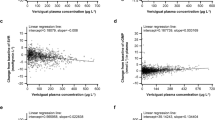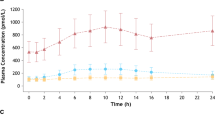Summary
The pharmacokinetic and pharmacodynamic properties of a new multiple-unit, controlled-release (CR) formulation of metoprolol1 (metoprolol succinate, 95 mg once daily), which has almost constant (zero-order) release properties over most of a 24-h dose interval, have been compared with those of conventional metoprolol tablets (metoprolol tartrate, 100 mg once daily and 50 mg twice daily), in 12 healthy male volunteers.
The steady-state plasma concentrations of metoprolol after five days of treatment varied less throughout the day with the CR than with the conventional formulation. This was associated with a considerably lower peak plasma concentration and the achievement of a significantly higher plasma concentration at the end of the dose interval.
Similarly, the effect on exercise-induced tachycardia was maintained at a relatively constant level throughout the day after treatment with the CR formulation. A significantly greater effect 24 h after administration was achieved with the CR formulation, when compared with once-daily dosing with metoprolol tablets, 100 mg.
Twice-daily dosing with metoprolol tablets, 50 mg, produced a similar β1-blocking effect at the end of the dose interval to that observed with metoprolol CR.
Although the steady-state plasma concentrations indicated significantly lower systemic availability for the CR formulation, compared with both regimens of metoprolol tablets, the total effect over the dose interval, expressed as the area under the efficacy curve (AUEC), was similar for the three treatments.
The relationship between steady-state plasma concentrations and the pharmacodynamic efficacy at corresponding times, indicated that plasma concentrations were more effectively utilized after the administration of the CR formulation than after the conventional tablet regimens.
The results of this study clearly indicate the potential benefits offered by the new metoprolol CR formulation, under all circumstances where a constant degree of β1-selective blockade, without plasma peaks and troughs, is preferred.
Similar content being viewed by others
References
Regårdh C-G, Borg KO, Johansson R, Johnsson G, Palmer L (1974) Pharmacokinetic studies on the selective β1-receptor antagonist metoprolol in man. J Pharmacokinet Biopharm 2: 347–364
Godbillon J, Evard D, Vidon N, Duval M, Schoeller JP, Bernier JJ, Hirtz J (1985) Investigation of drug absorption from the gastrointestinal tract of man. III. Metoprolol in the colon. Br J Clin Pharmacol 19 [Suppl 2]: 113S-118S
Johsson G, Regårdh C-G, Sölvell L (1975) Combined pharmacokinetic and pharmacodynamic studies in man of the adrenergic β1-receptor antagonist metoprolol. Acta Pharmacol Toxicol 36 (Copenh) [Suppl 5]: 31–44
Harron DWG, Balnave K, Kinney CD, Wilson R, Russell CJ, Shanks RG (1981) Effects on exercise tachycardia during forty-eight hours of a series of doses of atenolol, sotalol, and metoprolol. Clin Pharmacol Ther 29: 295–302
Ragnarsson G, Sandberg A, Jonsson UE, Sjögren J (1987) Development of a new controlled release metoprolol product. Drug Dev Ind Pharm 13: 1495–1509
Ervik M, Kylberg-Hanssen K, Johansson L (1986) Determination of metoprolol in plasma and urine using high-resolution gas chromatography and electron-capture detection. J Chromatogr 381: 168–174
Skelly JP, Barr WH (1985) Biopharmaceutic considerations in designing and evaluating novel drug delivery systems. Clin Res Pract Drug Reg Affairs 3: 501–539
Brockmeier D, Voegele D, von Hattingberg HM (1983) In vitro — in vivo correlation, a time scaling problem? Basic techniques for testing equivalence. Arzneimittelforsch 33: 598–601
Author information
Authors and Affiliations
Rights and permissions
About this article
Cite this article
Sandberg, A., Blomqvist, I., Jonsson, U.E. et al. Pharmacokinetic and pharmacodynamic properties of a new controlled-release formulation of metoprolol: A comparison with conventional tablets. Eur J Clin Pharmacol 33 (Suppl 1), S9–S14 (1988). https://doi.org/10.1007/BF00578406
Issue Date:
DOI: https://doi.org/10.1007/BF00578406




